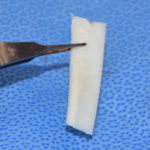Augmentative rhinoplasty requires either a graft or implant to perform. In most cases the use of the patient’s own septum or ear donor site is adequate. In more substantative dorso-columellar augmentations consideration must be given to either rib grafts or synthetic implants to achieve the desired effect. In some cases even an amalgamated approach can be used combining an implant (dorsal) with a cartilage graft. (tip)
There are well known advantages and disadvantages to both rib grafts and implants. Neither one is perfect. Rib grafts require a donor site and can be prone to warping. (if not diced) Implants have a higher risk of infection and can become displaced over time.
A third alternative does exist, however, that marries the benefits of both rib grafts and implants….that of cadaveric costal cartilage grafts. Harvested from cadavers through the Musculoskeletal Transplant Foundation (MTF), this allograft costal cartilage has several advantages. It eliminates the need for a donor harvest site which decreases operative time and lessens patient’s postoperative pain and scarring. They are minimally processed which helps preserve their biologic and mechanical integrity. (unlike irradiated or freeze-dried rib grafts from the past)

The costal cartilage allograft is another augmentative rhinoplasty option between rib grafts and synthetic nasal implants.
Dr. Barry Eppley
Indianapolis, Indiana


